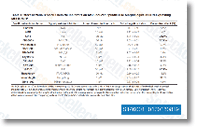Just after challenge with proteins triggering Synd1 shedding the cells have been fluo rescently stained working with E cadherin and Synd1 exact FITC conjugated monoclonal antibodies. E cadherin is known as a main transmembrane part from the apical junc tional complex. In a basic polarized epithelium the junctional inhibitor Olaparib complicated includes tight junctions and under lying adherens junctions playing a essential position while in the forma tion and maintenance of epithelial barriers.We as a result wished to see if the approach of Synd ectodomain shedding observed in our experiments is accompanied from the loss of intercellular contacts reflected from the dissocia tion within the junctional complicated. Our analyses unveiled obvious cytopathogenic alterations in handled NMuMG cells. In all situations, a network of E cadherin visible in untreated confluent cells turns into both disorganized, broken or disappears from intercellular contacts on treatment.
similar to what has become reported for VE cadherin in endothelial cells handled with LT.Partially conflu ent NMuMG erismodegib supplier cells show intensive Synd1 staining along the perimeter of cells, which partially or fully disappears from cell surfaces following incubation together with the shedding inducing proteins, whereas remnants from the ecto domain continue to be noticeable within the intercellular area.Notably, the taken care of cells retain a high intensity of DAPI blue fluorescence normal for undamaged nuclei, indicat ing the loss of E cadherin and Synd1 requires location from viable cells. Inhibition of Synd1 release The ectodomain shedding of cell surface molecules is typ ically mediated by host metalloproteinase sheddases.Both constitutive and accelerated shedding are inhibited by a range of substances lively within a variety of receptor and tension activated signaling pathways, which involve protein tyrosine kinases.
protein kinase C.and mitogen activated protein kinases.The exercise of LT in macrophages and epithelial cells  has been previously reported to involve down regu lation of MAPK kinase cascades.The outcomes of inhibition experiments are presented within the Table. It shows that piceatannol, a particular inhibitor of the Syk loved ones of PTKs is energetic in both spontaneous and induced Synd1 shedding for all examined proteins. During the case of AnlO and LT at minimal concentration of 0. 5 M the inhib itor exhibits some stimulatory result on the two constitutive and induced shedding, however it strongly inhibits Synd1 release in concentrations common for its activity assortment of five to 50 M.The result of piceatannol suggests that all 4 factors stimulate signaling pathways, which most almost certainly involve cytoplasmic Syk, nonetheless piceatannol has also been reported to inhibit other tyrosine kinases inside a comparable concentration array. In agreement together with the above suggestion the inhibitor of Src PTK household PP2 is thoroughly inactive.A
has been previously reported to involve down regu lation of MAPK kinase cascades.The outcomes of inhibition experiments are presented within the Table. It shows that piceatannol, a particular inhibitor of the Syk loved ones of PTKs is energetic in both spontaneous and induced Synd1 shedding for all examined proteins. During the case of AnlO and LT at minimal concentration of 0. 5 M the inhib itor exhibits some stimulatory result on the two constitutive and induced shedding, however it strongly inhibits Synd1 release in concentrations common for its activity assortment of five to 50 M.The result of piceatannol suggests that all 4 factors stimulate signaling pathways, which most almost certainly involve cytoplasmic Syk, nonetheless piceatannol has also been reported to inhibit other tyrosine kinases inside a comparable concentration array. In agreement together with the above suggestion the inhibitor of Src PTK household PP2 is thoroughly inactive.A
Microrna Mimics
Antagomirs and microRNA mimics have gained interest as a potential source of therapeutics.
